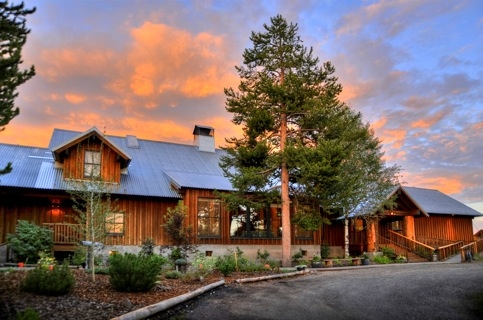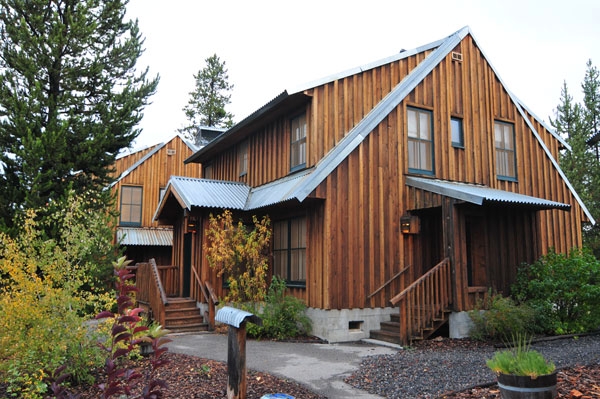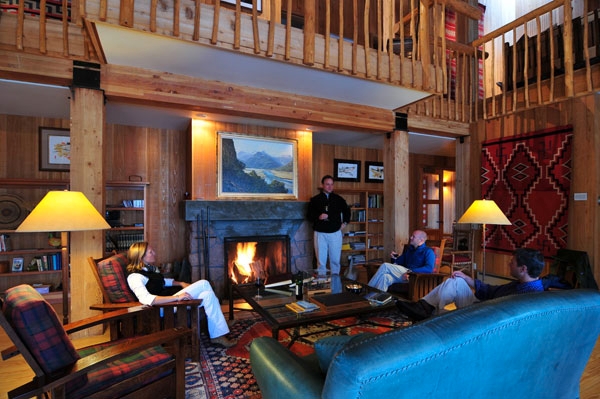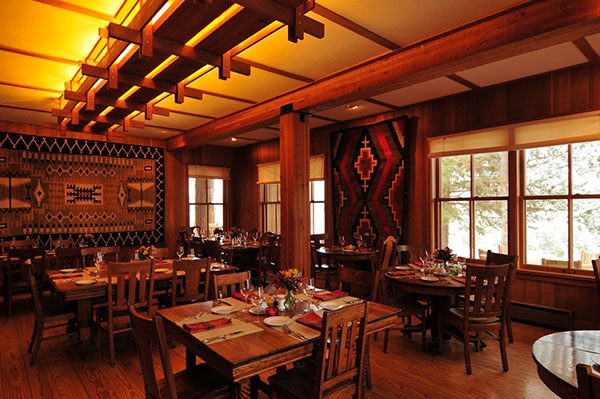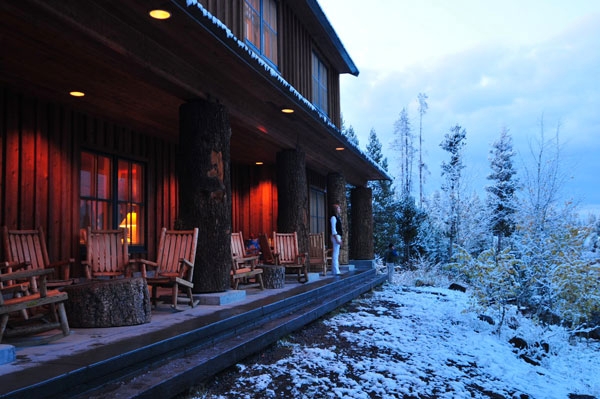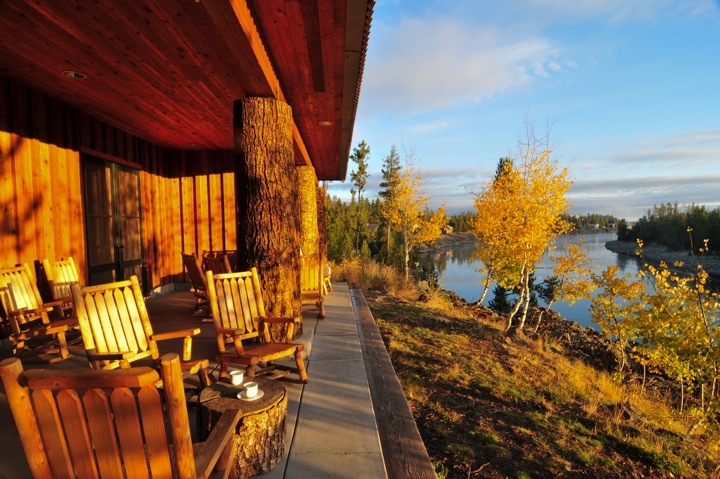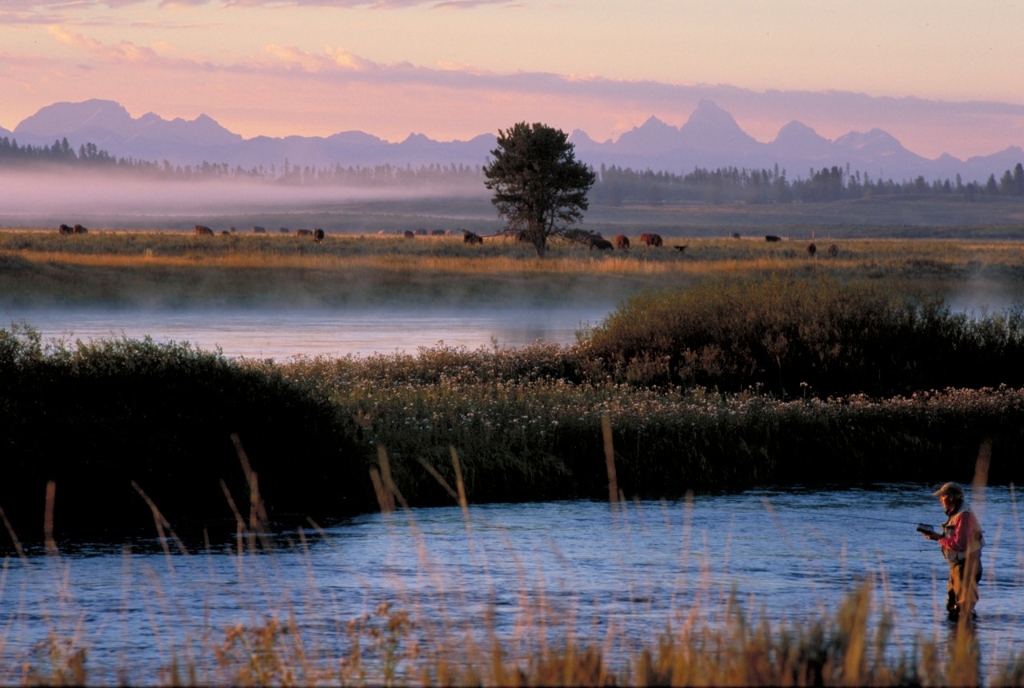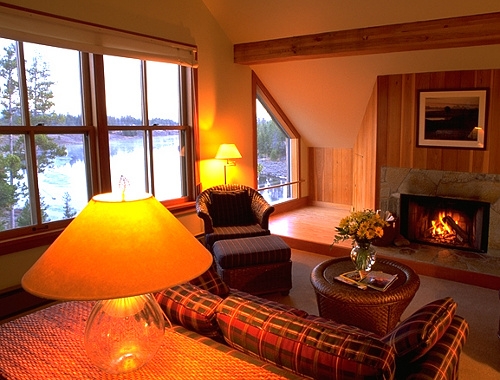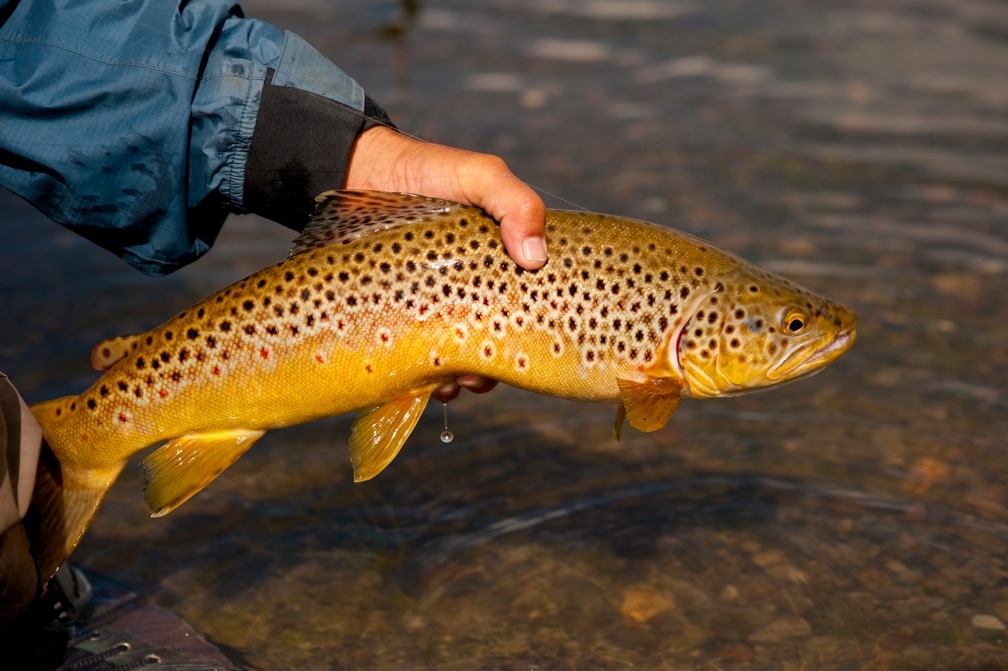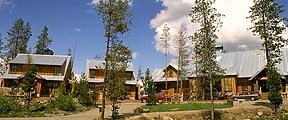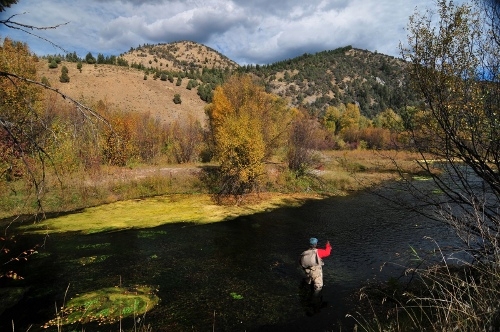Destination Overview
Built in 1991, this architecturally striking, rustic but luxurious main lodge and cabins are located on a bluff, overlooking the Henry’s Fork of the Snake River, one of the finest dry fly spots anywhere. Besides their home water, they have access to some of the finest guides in the West. Rivers like the Madison, South fork of the Snake, Firehole, Gallatin, Yellowstone and other rivers of Yellowstone Park, are all within easy reach for a day’s fishing. After a great day outdoors, rock away on the porch and relax with hors d’oeuvres and a beverage. Dining at Henry’s Fork Lodge is a blue-ribbon experience as well. “It’s no wonder that the Lodge is featured in the New York Times bestseller, “1000 Places to See Before You Die.” Non-fishers will enjoy hiking, birding, canoeing, horseback riding, mountain biking, tennis, golf, and sightseeing. Corporate welcome.
Accommodations and Lodging
Henry’s Fork Lodge was designed by, award-winning, architect, Joseph Esherick. Mountain buildings were one of his specialties, and because he was also an avid flyfisherman, he built in all the special features that anglers require. As a result, Henry’s Fork Lodge has been nominated for national architecture awards for its distinctive combination of elegance and comfort. The Lodge’s decor is highly distinctive, featuring wood paneling, antique furniture and oriental carpets. The accommodations at the Henry’s Fork Lodge follow a simple formula: great beds, windows with a magnificent view, deep reading chairs, warm fireplaces and elegant, rustic food. The long, open porch overlooking the river lined with oversized rocking chairs is an invitation to relax: the perfect way to unwind and share your fishing stories after an exciting day on the river.
They have six units in the main lodge, including two deluxe suites with fireplaces and big views of the Henry’s Fork, one with a separate bedroom and living room. They also have eight cottage suites; all have separate bedrooms and sitting rooms with fireplaces.
Dining
Dining is a sublime experience at Henry’s Fork Lodge. Whether it’s a hearty breakfast, a gourmet picnic lunch, or an elegant dinner, they’re restaurant has gained a reputation for having the finest cuisine in the Yellowstone area. Their menu changes daily to reflect what’s fresh and in season. They serve beer & wine and adjust meal times to “match the hatch,” so you never have to choose between dinner and the evening rise. It might be a good idea to make reservations ahead.
Fishing Information
The Henry’s Fork
Named the favorite river in the U.S. by members of Trout Unlimited, the Henry Fork offers 50 miles of highly varied water. The spring creek sections of Harriman Park and the fast water of the Box Canyon are world famous, but guides can show you lesser-known downstream sections that will open your eyes. This river offers the ultimate challenge to sophisticated anglers and also is very productive for inexperienced fly fishers. It can be fished both by wading and floating in a drift boat. The Henry’s Fork is spring fed and its flows are moderated by a reservoir, so it runs clear throughout the season. You can see rising rainbows and walk down to fish them right behind the lodge.
The Madison
The Madison originates in Yellowstone from the confluence of the Gibbon and Firehole Rivers. In the Park, it has the quiet character of a spring creek, and bison, elk or swans may accompany you, as you wade for browns and rainbows. Outside the Park, the river flows for more than 40 miles of boisterous nonstop riffles and runs offering great dry fly and nymph fishing, either from a boat or by wading. The Madison fishes best in the heat of summer, when prolific caddis hatches and an abundance of terrestrials like hoppers and ants draw the fish to the surface and to dry flies. It’s a big river in big, magnificent country—the epitome of Big Sky country.
The Yellowstone
One of the last great strongholds of the Yellowstone cutthroat (the native fish of this part of the Rockies). The Yellowstone’s fish, wildlife and scenery are a grand spectacle. All the fish are 16-20″ and can often be seen by the dozens in the water around you. They are naive in early season, but wise up as the season goes on. They are eager risers, so a hatch will almost always bring them up in the flat water of the fishable areas of the river. It’s definitely worth a trip through the Park whether or not you are fishing.
The Firehole and Gibbon
These two small to medium-sized rivers in Yellowstone Park are largely spring fed and flow together to form the Madison. Influenced by geysers and hot springs, they fish well with dry flies early and late in the season. You will fish near bison and elk, steam vents and geysers. Wading is easy and short casts are all you need.
Gallatin
This midsize river flows along the road to Bozeman and offers cutthroat in its upper section in Yellowstone Park, rainbows in the middle canyon section and browns in the lower valley section. The Gallatin offers good non-technical fishing so it’s a great place to wade in and learn.
Slough Creek and the Lamar River
Two cutthroat streams—Slough Creek and the Lamar River—are located in the beautiful north country of the Park, and also offer excellent fishing for rainbows near their confluence. For those who like to walk to better fishing, Slough’s upper meadows and the Lamar’s tributaries offer a great combination of hiking and fishing. There’s lots of wildlife, too, and many people have reported seeing wolves there.
The South Fork of the Snake
Some guides can take you on day trips to the South Fork, a huge river south of the Lodge that offers prolific and eager cutthroats along with some large browns. August, September and October are the most dependable months. Boats are essential, though you can wade some of the mid-river riffles and islands.
Hebgen Lake
Hebgen Lake is home of the “gulpers,” rainbows and browns that cruise the surface gobbling mayflies on summer mornings. You can use float tubes and canoes here for a stealthy approach. We like to fish Hebgen with dries until midday, and then go to a river for a different experience in the afternoon.
Henry’s Lake
Henry’s Lake is the best and most famous fly fishing lake in Idaho and home to the state record brookie. You can fish for big brookies in the fall and rainbow-cutthroat hybrids up to 6-7 lbs. on sinking lines. The Secret Spot Every guide has his secret spots and lesser-known places. You will also find a multitude of wonderful fishing places that are just overshadowed by the more famous and popular rivers and lakes.
Rates
Lodging, meals, double occupancy (3 night minimum) $450 per night*
Lodging, meals, single occupancy $575 per night*
6-night stay, meals and lodging only
– double occupancy $2,430 per person
6-night stay, lodging and meals, 5 days guided fishing,
– double occupancy, 2 anglers per guide $3,680-$3,740 per person
Deluxe suites in the main lodge are available for an additional $50 and $80 per person per night
*Per Person
Remember Fishermen’s Spot Travel services are always FREE to you! You never pay more than what you would pay if you booked directly with the lodge.
What’s Included:
- Three meals per day
- Pre-dinner beverages (no hard alcohol)
- Appetizers
- Airport transportation (8AM to 8PM) from Idaho Falls, or West Yellowstone.
What’s Not Included:
- Air transportation to and from the local airport
- Idaho State Bed Tax (8%)
- Idaho Fishing License and flies
- Gratuities for guides and staff
How to get there
DRIVING
From the South (The lodge is 68 miles or 1 hour, 10 minutes, between mile markers 376-377.) From the I-15, take Hwy 20 north out of Idaho Falls, towards West Yellowstone. After you pass through Ashton, 15 miles south of the lodge, you will cross the Henry’s Fork of the Snake River and begin an uphill climb into the forest. After you pass mile marker 376, look for the blue highway sign for Henry’s Fork Lodge and turn right onto “our” road. “(400 yards off the highway on a gravel road leading east off the highway.)”
From the North (West Yellowstone to lodge is 40 miles or 45 minutes. Take Hwy 20 West and South, toward Ashton, Idaho. You’ll cross the Henry’s Fork of the Snake and the Buffalo River, pass through the village of Last Chance and then cross the Henry’s Fork of the Snake again over Osborne Bridge, four miles south of Last Chance. Look for the blue highway sign for Henry’s Fork Lodge, about 2.5 miles south of the bridge and turn left onto “our” Road.
FLYING
You can fly into Idaho Falls or West Yellowstone. The lodge will transfer you to and from the lodge if between 8 AM – 8 PM at no cost to you.
Non-Angling Activity
Guests may hike, canoe, mountain bike or simply relax with a favorite book in the library or on the long river view porch to savor the singular beauty and wildness of the area. Activities at the Lodge are overseen by an exceptionally friendly, enthusiastic, and well-informed staff. Our hospitality and service is warm and welcoming.
Yellowstone National Park – Visiting Yellowstone National Park is one of our guests’ favorite activities. Only a 45 minute drive from the Lodge, the Park is a great place to spend a day – watching the bison, wolves, elk and other animals, taking in the spectacular scenery or exploring the geysers, hot springs and other unusual geologic features.
Short walks, longer hikes or driving tours are all great ways to see the Park. You can go on your own, combine touring with some fishing with a fishing guide or go on a naturalist-led private tour that we can arrange for you. If you’ve never seen Yellowstone or haven’t been back since you were a kid, you should save a day for the Park.
Hiking – Outstanding hiking opportunities everywhere from Harriman Park (5 minutes from the Lodge) to Yellowstone Park (45 minutes) and many other trail systems in the nearby area. Anything from easy strolls to all day hikes.
Horseback Riding – Excellent horses and all levels of rides are available at three stables, the closest 5 minutes away at Harriman Park.
Tennis and Golf – 18-hole championship course and country club in Rexburg. Club and cart rentals available. Scenic 9-hole course and four tennis courts at Island Park Village (20 minutes from the Lodge). Club and racket rentals available.
Mountain Biking – Excellent trail system 5 minutes away at Harriman Park. The Lodge has mountain bikes for guests-, so please ask us for them.
Canoeing – The Henry’s Fork from Big Springs to Mack’s Inn is a National Water Trail with great scenery and wildlife, or canoe from Harriman Park down the Henry’s Fork to the Lodge. Rentals available nearby.
Wildlife and Birdwatching – Outstanding opportunities in Harriman Park and Wildlife Refuge, Yellowstone Park (45 minutes), Red Rock Wildlife Refuge (1 hour) and many other nearby areas. Harriman Park and Red Rock Refuge are home to a major population of rare trumpeter swans. Moose, otters, bald eagles, osprey, trumpeters and other wildlife are often seen right from the Lodge.
Reading – The Lodge has an excellent collection of fishing and regional books and a comfortable upstairs library and riverview deck for reading.
Other Information
WHEN TO COME
Anytime you’re able to get away from Memorial Day through October is a good time to visit the Henry’s Fork and surrounding waters. The Henry’s Fork behind the Lodge runs clear all season and offers excellent dry fly fishing pretty much every day.
As a general guide to the season, Memorial Day through July 15 is prime time for the Henry’s Fork, Firehole and Madison in the Park and is the season of the famous hatches—green drake, brown drake, gray drake and salmonfly—and the most anglers.
July 15 to September 15 is prime time for the lower Madison, the Yellowstone, Lamar and Slough Creek in the Park and most of the lakes. September 15 to the end of October is the time all the waters become good, the crowds go home, the wildlife gathers, but the weather is cooler.
If you have a strong preference for a particular river or want to hit a specific hatch, then time of year is more important. Please inquire about a month-by-month description of the fishing.














